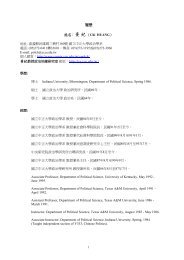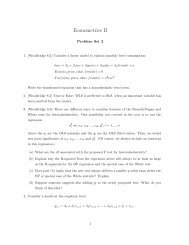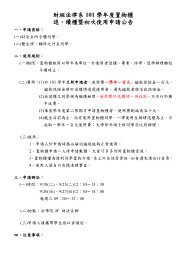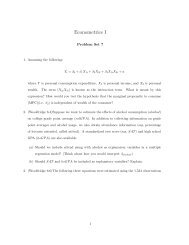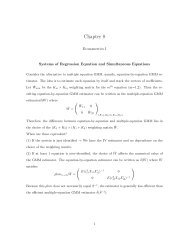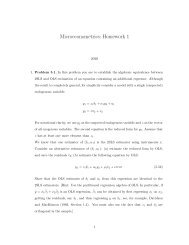Nucleotides and Nucleic Acids
Nucleotides and Nucleic Acids
Nucleotides and Nucleic Acids
- No tags were found...
You also want an ePaper? Increase the reach of your titles
YUMPU automatically turns print PDFs into web optimized ePapers that Google loves.
Chapter 10 . <strong>Nucleotides</strong> <strong>and</strong> <strong>Nucleic</strong> <strong>Acids</strong>coefficient. Stacked bases have a lower extinction coefficient than unstacked bases. Thus,denaturation is accompanied by an increase in ultraviolet light absorption, a phenomenonknown as the hyperchromic effect. The ultraviolet absorbance of denatured DNA isapproximately 40% higher than that of native DNA.7. BamHI produces 5'-overhangs as shown below:5' 3' 5' 5' 3'GGATCC G GATCC+CCTAGG CCTAG G3' 5' 3' 5' 3'Bgl II also produces 5'-overhangs as shown below:5' 3' 5' 5' 3'AGATCT A GTACT+TCTAGA TCTAG C3' 5' 3' 5' 3'The overhangs are compatible but the hybrid site formed by joining a BamHI half site with aBglII half site is not recognized by either. The junction is no longer a 6-base palindrome.5' 5' 3' 5' 3'G GATCT GGATCT+CCTAG A CCTAGA3' 5' 5' 5' 3'BamHI BglII hybridhalf-site half-site siteSummaryThe nucleic acids, ribonucleic acid (RNA) <strong>and</strong> deoxyribonucleic acid (DNA), are importantbiopolymers of nucleotides, compounds containing nitrogenous bases, a five-carbon sugar(ribose or deoxyribose) <strong>and</strong> phosphate. This chapter describes the basic biochemistry of nucleicacids <strong>and</strong> nucleotides. The nitrogenous bases come in two types, pyrimidines <strong>and</strong> purines.Pyrimidines are 6-membered, heterocyclic, aromatic ring structures containing two nitrogens.There are three principal pyrimidines: cytosine, uracil <strong>and</strong> 5-methyluracil or thymine. Cytosineis found in both DNA <strong>and</strong> RNA whereas uracil is in RNA <strong>and</strong> thymine in DNA. The generalstructure of a purine is a 5-membered imidazole ring fused to a pyrimidine ring. In DNA <strong>and</strong>RNA, there are two common purines, namely adenine <strong>and</strong> guanine. Both purines <strong>and</strong>pyrimidines contain numerous groups that can participate in hydrogen bonds as donors oracceptors or both. In fact, complementary groups exist on adenine <strong>and</strong> uracil (or thymine) <strong>and</strong>on guanine <strong>and</strong> cytosine such that they can form hydrogen-bonded pairs. This base-pairing isthe foundation for the structure of double-str<strong>and</strong>ed DNA.Because the bases have extensive, conjugated double bonds, they absorb light strongly in theUV range. The conjugated bond system allows delocalization of π-electrons, forming electronclouds above <strong>and</strong> below the base plane. Delocalized π-electrons can interact by base stacking,another force stabilizing double-str<strong>and</strong>ed DNA. Base stacking also affects the efficiency ofelectronic transitions of π-electrons, such that stacked bases absorb less UV light thanunstacked bases. The transition from an ordered nucleic acid structure stabilized by hydrogenbonds <strong>and</strong> base stacking to an unordered structure is accompanied by an increase in UVabsorbance. This transition is known as denaturation <strong>and</strong> it results in a hyperchromic shift inUV absorption.Purines <strong>and</strong> pyrimidines have low water solubility which improves when they are attached toeither ribose or deoxyribose sugars through N-glycosidic bonds. The resulting compounds are157





